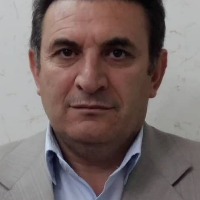Investigation of pattern and dynamics of Gharasu Ardabil River (from Samian Bridge to Sabalan dam)
One of the most important wealth of a nation is the water that is flowing in the rivers of that country, and because of its impact on the settlement, site selection and development of villages, cities, communication networks and agriculture, it is of great importance since the past. Because of this, human attention has been given to river systems as one of the most vital constituents of the earth's surface in a variety of respects. River morphology is a multifaceted branch of earth science that may be considered as a specific geomorphological subject. One of the most important purposes of investigating river morphology is the geometric description of river bed parameters and interpretation of its main causes with the help of the theoretical knowledge base of water flow, solids and sediment transport. Changes in river morphology can cause many problems, including river diversion, flooding of surrounding areas, damage to hydraulic structures, as well as some environmental impacts. Short-term river variability may be gradual and continuous, but the long-term variability or under certain conditions, it is inconsistent and abrupt. One of the factors that can severely impair the stability of rivers is the construction of dams. Flow changes by the dam can affect the amount, timing, and duration of upstream and downstream currents. The purpose of this study was to investigate the morphological changes (patterns and dynamics) of the Gharasu River (from Samian Bridge to Sabalan Dam) over a period of 19-years (2000–2019).
The study area of the Gharasu River is approximately 51 km 2 in geographical coordinates of 48 ° 2 min to 48 ° 18 min east longitude and 38 ° 22 min to 38 ° 30 min north latitude in the political-administrative boundary of the city of Ardabil. The highlands of the region are mainly composed of Eocene volcanic rocks. There are also two Quaternary units of Qsc and Qst related to Sabalan volcanic activity. The study area is located in the geological division of Iran in the Alborz-Azerbaijan zone. In most of Iran's construction divisions, the Azerbaijan region has been considered the continuation of central Iran. Topographic maps, geological maps, Landsat, Sentinel and Google Earth satellite imagery, digital elevation model (DEM) images, and climatic and hydrometric data were used in the study. In order to quantify the meandering development of alluvial rivers and determine the behavioral pattern and its changes over time, the geometrical characteristics of rivers such as central angle, meander radius, wavelength, valley length and bending coefficient ( Sinusitis), were measured and analyzed to determine changes in the course of the river channel from the past up to the present.
The mean radius of meanders for the entire Gharasu River channel during the study periods of 2000, 2010, and 2019 were 11.02, 100.90, and 99.40 meters; respectively, indicating a decreasing trend. The average length of arches during these years was 254.29, 250.24 and 251.74 meters; respectively. For this reason, over the years under the study, the mean central angle has an increasing trend from 138/50 in 2000 to 153/15 in 2010 and 157/41 in 2019. The mean curvature coefficients for the entire study period from the Gharasu River for the periods 2000, 2010 and 2019 were 1.58, 1.61 and 1.63;respectively. The values of this index during the years 2000, 2010 and 2019 were about 2.40, 2.52 and 2.58; respectively, which is of a severe meander type. The average rate of migration (Rm) of the study period from the Gharasu River during the years 2000 to 2010 was about 0.5 m / year. The value of this indicator for the period 2010 to 2019 has decreased to about 0.3 meters per year. According to calculations, the index has grown to about 0.4 m / year over the past 19 years (from 2000 to 2019). Another method called transect method was used to evaluate lateral variations of the study through the Gharasu River channel. According to calculations using the transect method over the past 19 years, a total of approximately 22.45 hectares of the Gharasu River margin lands have been lost due to erosion processes during the study period. This amount was about 13.75 ha during the period 2000 to 2010 and about 10.22 ha during the period 2010 to 2019.
In this study, the morphology and lateral variations of the ditch of Gharasu River in Ardabil province were evaluated. Based on geomorphological conditions, slope and width of the flood plain as well as other factors (such as river discharge variations), the river was divided into three sub-intervals and 30 transects in the study area. In addition to the visual interpretation, in order to evaluate and analyse the morphology of the Gharasu River, quantitative indicators were required. The present study used four indices of curvature, central angle of the cornice, channel migration rate and transect method to detect and identify the river pattern as well as lateral channel changes. These indices were calculated over the time periods of 2000- 2010, and 2010-2019 for the study river channel. The results showed that the Gharasu River has had a developed meander pattern in most of the studies. The results of the two channel migration rate indices and the transect method also confirmed that, overall, the transverse changes of the Gharasu River channel have been low. Also, these two indices, similar to the Cornis curve coefficient and the central angle, showed that transverse dynamics have declined sharply in the last decade.
Morphology , Transverse Changes , Remote Sensing , GIS , Gharasu , Ardabil
- حق عضویت دریافتی صرف حمایت از نشریات عضو و نگهداری، تکمیل و توسعه مگیران میشود.
- پرداخت حق اشتراک و دانلود مقالات اجازه بازنشر آن در سایر رسانههای چاپی و دیجیتال را به کاربر نمیدهد.





